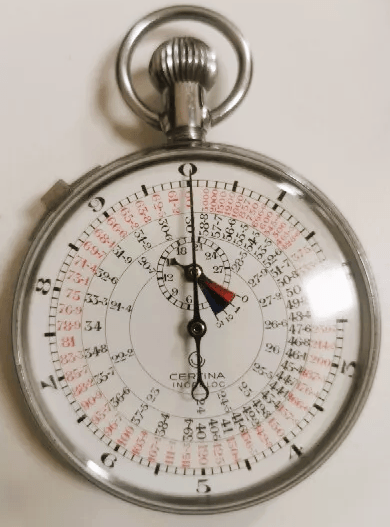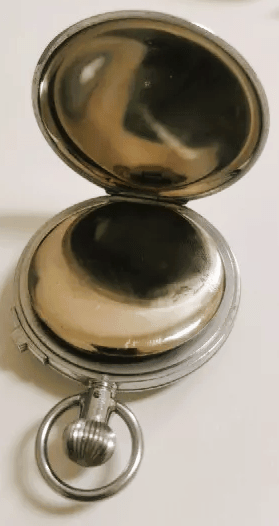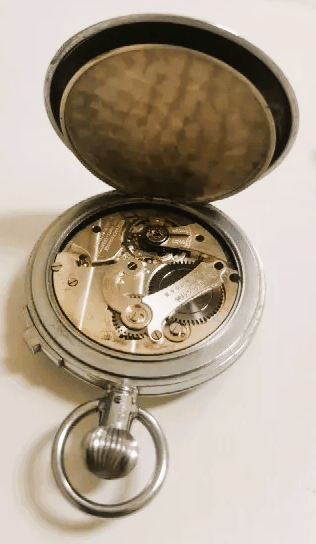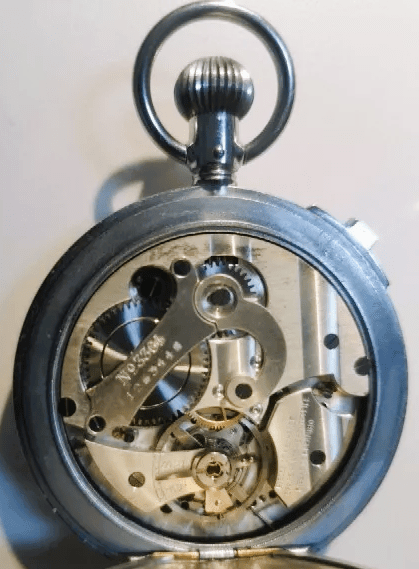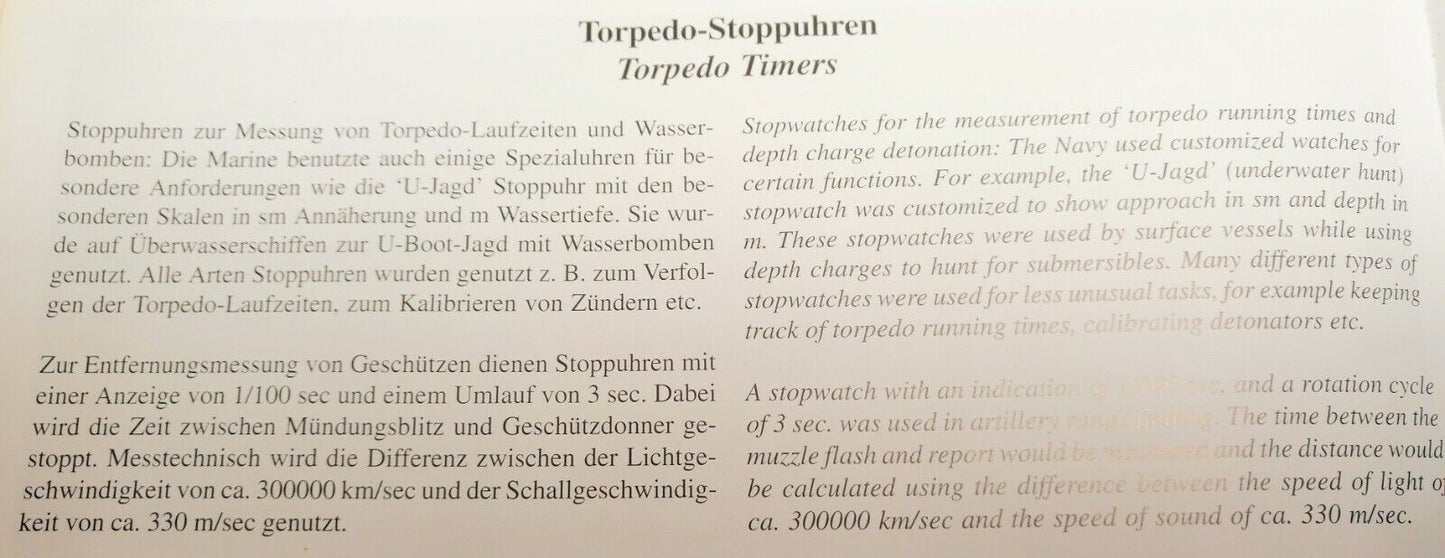Excelsior Park Certina
Certina Kurth Freres Excelsior Park Submarine Torpedo Running Time Artillery Stopwatch
Certina Kurth Freres Excelsior Park Submarine Torpedo Running Time Artillery Stopwatch
Couldn't load pickup availability
Subject of the auction:
Orig. Certina / Excelsior Park, extremely rare and sought-after export example of an early torpedo running time clock of the Allied forces of the Second World War with typical overhead indirect second and onion crown as usual with the ship's clocks of the Kriegsmarine at the end of the 1930s, see Knirim p. 256ff
The Swiss military and precision watch manufacturer Excelsior Park was and is known for its extremely high-quality chronographs and stopwatches, especially before and during World War II. Since Excelsior Park was a Swiss manufacturer, unlike Junghans, Hanhart, Kienzle, and others, this manufacturer naturally supplied not only the German Wehrmacht but also the Allied World War II opponents.
What makes this rare piece particularly rare and authentic is its dial, specially developed for submarine use, with a tachymeter scale precisely calibrated to the torpedoes, starting at 3,000 meters—the maximum distance of a submarine from the ship being attacked—then running down to 0 meters, the torpedo impact point. If no beep was heard on the torpedo travel time stopwatch after this time, the commander knew he had missed and needed to reload.
Above are a few sample photos of these very special Torpedo-running watches from Konrad Knirim's "Bible of Military Watches." It's clear that these also came from Junghans and Hanhart on the German side (the photos show a Hanhart with an identical dial/scale layout according to the Kriegsmarine's specifications).
A super rare piece of military and naval watch history, which only very rarely comes onto the market. Apparently, the well-known Certine / Kurth Freres watch manufacturer and supplier to the Wehrmacht in World War II built this watch, purchasing the dial and movement.
Description:
The 100% original Torpedo running time watch, stop watch has the usual dimensions for the Navy: 50mm case diameter, unrestored, best preserved, white, "Certina" signed dial with top, indirect second, onion crown, side slider to start the stop function, strangely enough, this is triggered by the slider and not by the crown, which only sets to zero
Sparkling clean, signed movement with Excelsior Park-typical spare parts compartment, three-lid clock, both lids close absolutely flush and rock solid
The stopwatch is fully functional! The signed movement is spotless, the case and crystal show barely noticeable signs of age or wear, and the unrestored dial has the damage/chip visible in the photos.
Condition:
EZ: 1 - 2, best collector's condition, dial unrestored and fully signed, flawless! Barely noticeable signs of age or wear. Winds smoothly, starts and runs continuously, accuracy not tested.
History of the Kurth Freres (military) watch manufactory (source: Wikipedia):
Certina SA
| Certina SA | |
|---|---|
|
|
|
| Legal form | stock corporation |
| Founding | 1888 |
| seat | Le Locle , |


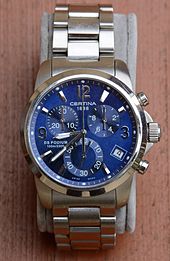
Certina SA is a Swiss luxury watch manufacturer based in Le Locle , offering watches in the mid- to high-price segment. It built its own calibers until 1985 [ 1 ] and is now part of the Swatch Group . The name Certina is derived from the Latin "certus," meaning "safe, certain."
Pursue
Story
In 1888, the brothers Adolf and Alfred Kurth founded the Certina Kurth Frères factory in Grenchen for the production of watch movements and watch parts. A few years later, they began producing complete watches. In its founding year, the company employed three technicians, working in a workshop directly attached to the family home. After several expansions (1938: 250 employees, 1955: 500 employees), production reached its peak in 1972, with 600,000 manufactured watch movements per year and a workforce of 900.
One of the particularly durable models of Kurth Freres SA Grenchen around 1944 was the Certina Labora , a shock-resistant , waterproof and anti-magnetic wristwatch.
In 1983, Certina joined the SMH (Swiss Society for Microelectronics and Watch Industry AG, now Swatch Group ) and became the sports watch brand within the group.
Brand name
The first watches were sold under the name "Grana." Grana was derived from "Granacus," the Latin name for Grenchen. Until 1938, watches were manufactured and sold under various brand names, including the Certina brand. After that, it was decided to continue to maintain the Certina brand only.
Certina won both the International Diamonds Award and the Golden Rose . [ 5 ]
DS – Double Security
In 1959, Certina engineers developed the DS principle. DS stands for double security. The idea was to build an extremely durable watch case that would reliably protect the movement even under extreme stress. The key element is that the movement is decoupled from the case by a rubber ring that absorbs strong impacts, and the crown is secured with a double seal (a screw-on closure came later on Certina Divers), which makes it difficult for moisture to penetrate. The crown spindle is only loosely connected and can therefore shift axially and laterally if necessary when subjected to impact. A second O-ring sits on the crown spindle in addition to the O-ring in the crown. In addition to increasing water resistance, this principle also has the advantage that shocks to the crown are not directly transmitted to the movement, but are absorbed beforehand.
Sponsorship
Since the post-war period and with the development of the DS design, Certina has sponsored athletes, sporting events and extreme expeditions.
From 2005 to 2015, Certina sponsored the Swiss Formula 1 team Sauber
History of the military and precision watch manufacturer Excelsior Park:
Swiss watchmaking
Excelsior Park was founded in 1866 by Jules-Frédéric Jeanneret in Saint-Imier as the watchmaking business JF Jeanneret. In 1888, Jeanneret's three sons took over the company. Samuel Jeanneret continued to run the older company Veuve Jules-Frédéric Jeanneret. Albert Jeanneret then founded Albert Jeanneret & Frères and in March 1891 Albert Jeanneret applied for a patent for a chronograph. In 1893 he left the factory to his sons Henri Jeanneret-Brehm and Constant Jeanneret-Droz who separated again in 1902. Henri continued the company under the name Jeanneret-Brehm & Cie. Constant initially worked on his own account and in 1912 bought the Leonidas watch factory.
When the heyday of timepieces for sports enthusiasts began in the 1930s, the company launched an exceptionally wide range of timepieces under the Exelsior Park brand name, also incorporating chronograph calibers from other Swiss manufacturers. The company was so successful with this range that it began developing its own calibers. These successes and numerous honors testify to its high status. Excelsior Park also supplied chronograph movements for companies such as Gallet & Co. , Zenith , and Girard-Perregaux .
An offer from the sole proprietorship Reiner Haas, Managing Director is Reiner Haas
|
|
|
